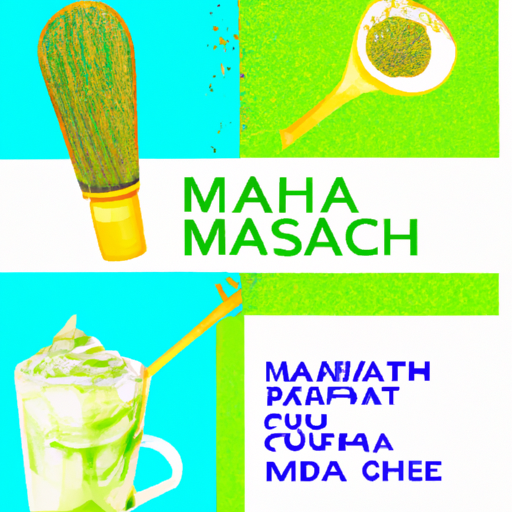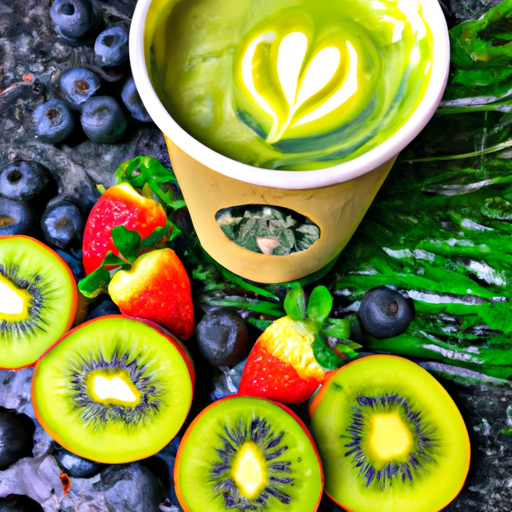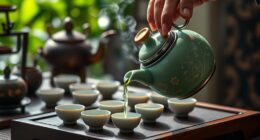I’m a big admirer of matcha, the finely milled green tea powder which has played a central role in Japanese tea rituals for hundreds of years. Its distinct taste is earthy and a little bitter, yet it carries a subtle sweetness and a creamy, smooth texture.
But as much as I enjoy drinking matcha on its own, I know that it can be even more delicious when paired with other flavors.
In this article, I will explore the different flavor profiles that go well with matcha, from sweet and fruity to nutty, spicy, and herbal. Whether you are looking to create a tasty beverage, a delectable dessert, or a savory dish, there are countless ways to incorporate matcha into your cooking and baking repertoire.
So let’s dive in and discover the best flavor combinations for this versatile ingredient!
Key Takeaways
- Matcha pairs well with sweet flavors like chocolate and caramel, as well as citrus fruits and nuts.
- Spicy flavors like ginger, cinnamon, and cardamom can create a unique and exciting taste experience when paired with matcha.
- Matcha can add depth and complexity to desserts and can also be incorporated into savory dishes like pasta, marinades, and roasted vegetables.
- Matcha can be paired with other flavors like mint, basil, thyme, fruit, and cardamom to enhance its taste.
Understanding the Flavor Profile of Matcha
Delving into the intricacies of matcha’s flavor profile offers insight into which complementary flavors can enhance its unique taste. Exploring the taste of matcha can be an adventure for the taste buds. Matcha is earthy, vegetal, and has a slightly bitter taste. It has a distinct umami flavor, which is the result of its high concentration of amino acids.
Pairing matcha with different cuisines can yield fantastic results. Matcha has been used for centuries in Japanese tea ceremonies, and it pairs well with Japanese cuisine, such as sushi, mochi, and wagashi. However, matcha’s versatility extends beyond Japanese cuisine. It can also be used to flavor and enhance other dishes, such as smoothies, cakes, and ice cream.
Moving on to sweet flavor pairings, matcha goes well with sweet flavors, and its bitterness can help balance out the sweetness. For example, matcha can be paired with honey, which adds a natural sweetness and a floral flavor that complements the earthy taste of matcha. Another great pairing is matcha and chocolate, which creates a rich and indulgent flavor that is both sweet and bitter.
Overall, understanding the flavor profile of matcha can help us create unique and delicious flavor combinations.
Sweet Flavor Pairings
Indulge in the creamy sweetness of vanilla ice cream or the rich, decadent taste of chocolate cake as you savor the earthy notes of matcha. Matcha and chocolate make a perfect pair, as the bitterness of the matcha complements the sweetness of the chocolate. The combination creates a unique flavor profile that is both indulgent and refreshing.
Whether you’re looking for a sweet treat or a dessert to impress your guests, matcha and chocolate is a winning combination. Another sweet flavor pairing that works well with matcha is caramel. The deep, rich flavor of caramel adds a creamy sweetness to the earthy notes of matcha. The combination creates a complex flavor profile that is both delicious and indulgent.
Whether you’re enjoying a caramel latte or a slice of caramel cake, adding matcha to the mix can take your dessert to the next level. Incorporating matcha into your sweet treats is a great way to add depth and complexity to your desserts. Whether you’re a fan of chocolate or caramel, there are endless possibilities when it comes to pairing matcha with sweet flavors.
In the next section, we’ll explore how fruity flavors can be paired with matcha to create a refreshing and delicious combination.
Fruity Flavor Pairings
If you’re in the mood for something refreshing, why not try adding a splash of citrus to your matcha? Just like how a squeeze of lemon can brighten up a dish, a hint of orange or grapefruit can add a zesty kick to your matcha drink. Think of it like adding a burst of sunshine to your day!
For a delicious smoothie combination, try blending matcha powder with fresh orange or grapefruit juice, a frozen banana, and some almond milk. The result is a creamy, tangy, and energizing drink that’s perfect for breakfast or a mid-day snack.
Matcha also pairs well with fruity baked goods. For example, try incorporating matcha powder into your favorite muffin or cake recipe, and top it with a citrus glaze. The matcha adds an earthy, slightly bitter note that complements the sweetness of the fruit.
Another idea is to mix matcha powder with strawberry or raspberry jam, and spread it on toast or a croissant. The jam adds a burst of fruity flavor, while the matcha adds a subtle hint of green tea.
In addition to smoothies and baked goods, there are many other ways to incorporate fruity flavors into your matcha routine. For example, you could mix matcha powder into a fruit salad dressing, or add it to a homemade granola recipe that includes dried fruit. You could also pair matcha with fresh berries, either by blending them into a smoothie or topping your matcha bowl with them.
With so many delicious options, it’s easy to see why fruity flavors are a popular choice for matcha lovers. Speaking of popular choices, let’s move on to our next section about nutty flavor pairings.
Nutty Flavor Pairings
Pairing matcha with nutty flavors creates a harmonious blend of earthy and rich notes that elevate the taste and aroma of the tea. The nutty flavors complement the grassy and vegetal flavors of matcha, creating a unique taste that is both comforting and energizing. Roasted nuts and nut butters, such as hazelnuts, almonds, and cashews, are excellent choices for pairing with matcha. Their toasty and nutty flavors add depth and complexity to the tea, making it more satisfying to drink.
To further enhance the nutty notes in matcha, coconut and almond milk can be added to create a creamy and luscious texture. These dairy-free alternatives also add their own distinct flavors to the matcha, making it even more enjoyable to consume. Coconut milk, in particular, adds a subtle sweetness that balances out the bitterness of the matcha, while almond milk adds a nutty and slightly sweet flavor that complements the earthy taste of the tea.
Incorporating nutty flavors into matcha not only adds a new dimension of taste and aroma to the tea, but it also provides health benefits. Nuts are a good source of healthy fats, vitamins, and minerals, making them a nutritious addition to any diet. Drinking matcha with nutty flavors is a great way to reap the benefits of both matcha and nuts, while also satisfying your taste buds. Next, we will explore how matcha can be paired with spicy flavors to create a unique and exciting taste experience.
Spicy Flavor Pairings
I absolutely love adding a little kick to my matcha drinks, and one of my favorite ways to do so is by incorporating spicy flavor pairings.
Ginger adds a nice zing and has been shown to have anti-inflammatory properties.
Cinnamon and cardamom have a warm and comforting flavor that pairs perfectly with the earthy notes of matcha.
These three spices are my go-to choices for adding a little heat to my matcha.
I can’t imagine enjoying my matcha without them!
Ginger
Adding ginger to matcha can create a delicious and invigorating flavor combination. Not only does it taste great, but ginger also offers a variety of health benefits. Here are four reasons why you should consider adding ginger to your matcha:
-
Boosts digestion: Ginger has been shown to improve digestion by increasing the production of digestive juices, which helps to break down food more efficiently.
-
Reduces inflammation: The anti-inflammatory properties of ginger can help to reduce inflammation in the body, which can lead to a variety of health problems.
-
Improves brain function: Studies have shown that ginger can improve cognitive function and may even help to prevent age-related cognitive decline.
-
Enhances immune function: Ginger has been shown to boost the immune system, helping to protect the body against illness and disease.
If you’re looking for a recipe to try, consider making a ginger matcha latte. Simply mix matcha powder with hot water and ginger syrup, then add frothed milk for a creamy and delicious drink.
Moving on to the next subtopic, cinnamon is another flavorful addition to matcha that can offer a variety of health benefits.
Cinnamon
Sprinkled on top of your matcha latte, cinnamon not only adds a touch of warmth and coziness, but it also offers numerous health benefits. Cinnamon is known to lower blood sugar levels, reduce inflammation, and improve brain function. Additionally, it’s high in antioxidants and has anti-cancer properties.
To incorporate cinnamon into your matcha latte recipe, simply sprinkle a small amount on top or mix it in with your milk or sweetener before adding it to your matcha. You can also add a cinnamon stick to your latte for a stronger flavor. Not only will it add a delicious taste, but it’ll also provide a boost of health benefits to your daily routine.
Moving onto the next topic, cardamom is another flavorful addition to your matcha latte that you won’t want to miss out on.
Cardamom
Cinnamon is a classic spice that pairs well with matcha, but let’s not forget about cardamom. Cardamom is a spice that is native to India and is often used in traditional Indian cuisine. It has a sweet and savory flavor that can add depth to matcha drinks and desserts.
Cardamom has several health benefits that make it an excellent addition to matcha. It is known for its anti-inflammatory properties and can help with digestion and gut health. It also contains antioxidants that can help protect against disease and promote overall well-being. The best way to incorporate cardamom into matcha recipes is by adding ground cardamom directly to the matcha powder before mixing with water or milk. You can also infuse cardamom pods in milk or cream before adding to your matcha latte.
| Cardamom in Matcha | Flavor Profile | Health Benefits |
|---|---|---|
| Ground Cardamom | Sweet and Savory | Anti-inflammatory, promotes digestion |
| Cardamom Pods | Warm and Spicy | Antioxidants, improves gut health |
Cardamom is a great spice to pair with matcha. It has a unique flavor profile that adds depth and complexity to any recipe. Plus, its health benefits make it a great addition to a healthy and balanced diet. Moving forward, let’s explore how savory flavors can complement matcha in unexpected ways.
Savory Flavor Pairings
If you’re looking to expand your culinary horizons, you might want to try experimenting with savory flavors that complement the earthy and vegetal notes of matcha. Matcha is a great ingredient to add to savory dishes because it adds a unique depth of flavor and umami taste. Umami is a savory taste that comes from glutamates and is found in foods like mushrooms, soy sauce, and Parmesan cheese. When paired with matcha, it creates a delicious combination that is both savory and rich.
One unexpected pairing that works really well with matcha is using it in non-traditional savory dishes. For example, adding matcha to a marinade for grilled chicken or fish can add a delicious and unique flavor. You could also try adding matcha to a soup broth or using it as a seasoning for roasted vegetables. The possibilities are endless, and it’s a great way to experiment with new flavors and recipes.
Overall, there are many savory flavor pairings that work well with matcha. By exploring the savory side of matcha, you can create unique and delicious dishes that are both healthy and flavorful.
In the next section, we will explore herbal flavor pairings that also complement matcha well.
Herbal Flavor Pairings
I personally love experimenting with different herbal flavor pairings when it comes to matcha. Three of my favorite herbs to use with matcha are mint, basil, and thyme. Each of these herbs brings its own unique flavor profile to the table. Mint adds a refreshing and cooling note, while basil brings a slightly sweet and spicy flavor, and thyme offers a subtle earthy tone.
Let’s dive into each of these herbs and how they complement matcha.
Mint
Mint, with its refreshing and cooling properties, is a perfect complement to the earthy and slightly bitter flavor of matcha. It not only adds a burst of flavor but also provides various health benefits.
Here are three ways to incorporate mint into your matcha routine:
-
Mint Matcha Latte: Brew a cup of matcha and add some fresh mint leaves before whisking in milk and honey. This latte is not only delicious but also a great way to start your day with a boost of energy and antioxidants.
-
Mint Matcha Smoothie: Blend matcha powder, fresh mint, frozen bananas, and almond milk for a delicious and healthy smoothie. This recipe is perfect for a quick and easy breakfast or a post-workout snack.
-
DIY Mint Matcha Face Mask: Mix matcha powder, fresh mint leaves, and honey for a soothing and rejuvenating face mask. Apply it to your face and leave it on for 10-15 minutes before rinsing off with warm water. Your skin will feel refreshed and glowing.
As much as I love mint, basil is another herb that pairs well with matcha.
Basil
You may be hesitant to try basil with your matcha, but trust me, the herb’s subtle sweetness and floral notes complement the earthiness of matcha perfectly. Basil infused matcha drinks are a great way to experience this unique flavor combination.
A simple recipe involves steeping fresh basil leaves in hot water, adding matcha powder and a sweetener of your choice, and blending it all together with ice for a refreshing summer drink. But basil doesn’t have to be limited to just sweet drinks.
There are also savory basil matcha recipes that showcase the herb’s versatility. For example, a basil and matcha pesto can be used as a sauce for pasta or a dip for vegetables. The combination of the fresh green flavors of matcha and basil with the nuttiness of pine nuts and the sharpness of Parmesan cheese is a match made in heaven.
Now, let’s move on to the next herb in our flavor exploration – thyme.
Thyme
If you’re looking to add a unique twist to your matcha recipes, thyme might just be the herb you’re looking for. When it comes to using thyme in savory matcha dishes, it’s important to balance out the strong flavor profile of matcha with the right amount of thyme. One way to do this is by using fresh thyme leaves, which have a more delicate flavor compared to dried thyme. You can add it to your matcha-based pasta sauces, soups, and even stir-fries for a refreshing twist.
But did you know that thyme can also be paired with matcha in cocktails? Yes, you read that right! The earthy, slightly floral notes of thyme can complement the grassy flavor of matcha in a refreshing drink. One popular thyme and matcha cocktail is the Matcha Mule, which combines matcha, ginger beer, thyme, and lime juice for a unique and flavorful beverage. So, the next time you’re looking to experiment with matcha, don’t hesitate to add a sprig or two of thyme to the mix.
Moving on to beverage flavor pairings, there are a few flavors that go particularly well with matcha.
Beverage Flavor Pairings
Pairing matcha with other flavors can create a delicious and unique beverage experience. Exploring unusual beverage pairings is a fun and exciting way to discover new tastes and experiment with different ingredients.
When it comes to matcha, there are countless flavor combinations that can be used to create a truly unforgettable drink. One way to create unique matcha cocktails is to pair it with fruit flavors like strawberry, raspberry, or mango. The sweetness of the fruit complements the earthy and slightly bitter taste of matcha, resulting in a well-balanced and refreshing beverage.
Another option is to mix matcha with citrus flavors such as lemon or lime. The tangy and zesty taste of the citrus adds a bright and lively element to the drink. For those who enjoy a more savory and spicy taste, matcha can also be paired with ingredients like ginger, turmeric, or even chili pepper. These flavors add a bold and complex taste to the matcha, making it a perfect choice for those who like to experiment with unique and unexpected flavor combinations.
Whether you prefer sweet or savory drinks, there is a matcha cocktail out there that’s sure to satisfy your taste buds. Pairing matcha with different flavors can be truly exciting and rewarding. But why stop at drinks? There are also countless dessert recipes using matcha that can be explored and enjoyed.
Dessert Recipes Using Matcha
Indulging in delectable matcha-infused desserts is a must-try for any food lover. Options range from matcha ice cream to matcha cheesecake. If you’re a fan of ice cream, then you must try matcha-infused ice cream. This ice cream is a perfect balance of sweet and bitter, making it a unique and refreshing treat.
Matcha ice cream is made using matcha powder, milk, and cream. The result is a smooth, creamy, and flavorful dessert that is perfect for warm summer days.
Another dessert that you should try is matcha tiramisu. This dessert is a twist on the classic Italian dessert, using matcha instead of espresso. Matcha tiramisu has layers of matcha-infused cream, ladyfingers, and cocoa powder. The matcha flavor adds a subtle earthy taste to the dessert, making it a perfect after-dinner treat.
This dessert is easy to make and can be prepared ahead of time, making it a great option for entertaining guests.
While matcha desserts are delicious, incorporating matcha into savory recipes is also a great way to enjoy this unique flavor. But before we delve into that, let’s explore some more matcha-infused dessert options.
Savory Recipes Using Matcha
I’m excited to talk about some savory recipes using matcha! Matcha isn’t just for sweet treats, it can also add a unique flavor to savory dishes.
Some savory recipes to try include Matcha Salt, which can be used to season meats or vegetables.
Matcha Pasta can be a fun twist on traditional pasta dishes.
Matcha Dressing can add a pop of color and flavor to salads.
Matcha Salt
Adding matcha salt to your recipe can give it a subtle, earthy flavor that complements the richness of your dish. Matcha infused dishes are becoming increasingly popular, and adding matcha salt is an easy way to elevate the flavors of your dishes.
You can find different types of matcha salt blends in specialty stores or make your own by mixing sea salt with matcha powder. When making matcha salt, it’s important to use high-quality ingredients to ensure that the flavors of the matcha and salt are balanced.
You can use matcha salt in a variety of savory recipes, such as roasted vegetables, grilled meats, or even popcorn. It adds a unique twist to any dish and is a great way to incorporate matcha into your cooking.
As for matcha pasta, it’s a great way to add a vibrant green color and subtle earthy flavor to your pasta dishes. To make matcha pasta, you simply mix matcha powder with flour and eggs to create a dough. From there, you can shape the pasta into your desired shape and cook it as you would any other pasta.
It’s a fun and unique way to incorporate matcha into your cooking, and it pairs well with a variety of sauces and toppings.
Matcha Pasta
To create a unique and vibrant green pasta dish, you’ll want to try making matcha pasta and see for yourself how it adds depth to your culinary creations. To make matcha pasta, simply mix matcha powder with flour and eggs. The result is a beautiful green dough that can be cut into any shape you desire.
Here are some delicious ways to use matcha pasta:
- Toss it with olive oil, garlic, and cherry tomatoes for a simple yet flavorful dish.
- Pair it with Matcha pesto, made by blending basil, pine nuts, Parmesan cheese, and matcha powder. This combination adds a unique twist to the traditional pesto sauce.
- Use it as a base for a seafood dish, like clams or shrimp, and top it with a creamy matcha sauce.
- Make Matcha bread crumbs by toasting matcha bread and pulsing it in a food processor. Use these crumbs to top the pasta for a crunchy texture.
- Mix it with sautéed vegetables like bell peppers, mushrooms, and zucchini for a healthy and colorful pasta dish.
Matcha pasta is a versatile ingredient that can be used in many dishes.
Next, let’s explore how to use matcha in dressings.
Matcha Dressing
I absolutely loved the idea of incorporating matcha into pasta, but now I’m excited to explore the other possibilities of using matcha in savory dishes. One of my favorite ways to use matcha is by making a delicious and healthy matcha dressing for my salads.
Matcha dressing is incredibly easy to make – just whisk together some olive oil, honey, rice vinegar, and of course, matcha powder. The result is a beautiful green dressing with a subtle earthy flavor and a slight sweetness. I love drizzling this dressing over a simple salad of mixed greens, cucumbers, and cherry tomatoes. It’s a refreshing way to incorporate matcha into my diet and it’s perfect for those hot summer days.
In addition to using matcha dressing in salads, I also love incorporating matcha into marinades. The slightly bitter taste of matcha pairs perfectly with soy sauce, ginger, and garlic. I like to marinate chicken or fish with this mixture and then grill it for a delicious and healthy meal.
The matcha adds a unique flavor to the dish and it’s a great way to sneak in some extra antioxidants into my diet. Overall, I’m excited to continue experimenting with matcha in different savory dishes and discovering new ways to incorporate it into my meals.
Frequently Asked Questions
What are the health benefits of matcha?
As someone who’s interested in health and wellness, I’ve researched the health benefits of matcha extensively.
Matcha is a type of green tea that’s ground into a powder and traditionally used in Japanese tea ceremonies. It’s become increasingly popular in the Western world due to its numerous health benefits.
Compared to regular green tea, matcha is higher in antioxidants and can help boost metabolism and promote weight loss. It also contains L-theanine, an amino acid that can help reduce stress and improve mood.
Additionally, matcha has been shown to improve brain function and lower the risk of heart disease and type 2 diabetes.
If you’re looking to incorporate matcha into your diet, there are many delicious matcha smoothie recipes available online that can help you reap the health benefits of this superfood.
Is matcha more bitter than other types of tea?
When it comes to taste comparison, matcha and black tea are quite different. Matcha tends to have a more bitter taste due to the high concentration of amino acids. However, this bitterness can be balanced with sweetness by adding honey, agave, or even a touch of vanilla.
It’s important to note that the quality of matcha can also affect its bitterness. Higher quality matcha tends to have a smoother, less bitter taste. Overall, it’s all about finding the right balance to suit your taste buds.
Can matcha be used in savory dishes other than Japanese cuisine?
I’ve been experimenting with incorporating matcha into savory dishes beyond traditional Japanese cuisine, and I’ve been pleasantly surprised with the results. Matcha has a unique earthy, slightly bitter flavor that pairs well with a variety of ingredients.
Some of my favorite matcha flavor pairings include citrus (like lemon or orange), ginger, garlic, and soy sauce. I’ve used matcha in marinades for chicken and tofu, as a seasoning for roasted vegetables, and even in a creamy matcha risotto.
Overall, I’ve found that adding matcha to savory dishes can be a fun and creative way to explore its flavor profile, and I’m excited to continue experimenting with new matcha recipes.
Should matcha be consumed hot or cold?
When it comes to enjoying matcha, it really depends on your personal preference whether you prefer it hot or cold. Hot matcha is a traditional way to consume it, and can be comforting and soothing, especially on a chilly day.
On the other hand, cold matcha can be refreshing and energizing, making it a great choice for a hot summer day. Additionally, matcha can also be used in cocktails and other beverages for a unique and delicious twist.
Whether you prefer it hot or cold, there are plenty of ways to enjoy the many benefits and flavors of matcha.
How does the quality of matcha affect its flavor profile?
When it comes to matcha, the quality of the tea leaves plays a crucial role in determining the taste variability.
Matcha grading is based on the color, texture, and flavor of the tea leaves.
Higher grades of matcha are made from the youngest, most tender leaves, and are harvested by hand.
These leaves are then finely ground into a powder, resulting in a smoother, creamier texture and a sweeter, more delicate taste.
On the other hand, lower grades of matcha tend to have a more bitter taste and a coarser texture.
When it comes to flavor, the quality of matcha can make a significant difference in how it tastes, and it’s important to choose a grade of matcha that suits your preferences.
Conclusion
In conclusion, matcha is a versatile ingredient that can be paired with a variety of flavors. Its unique taste profile makes it a perfect addition to sweet, fruity, nutty, spicy, and herbal dishes. It can also enhance the taste of beverages, both hot and cold, and make desserts and savory dishes more interesting.
As the saying goes, "matcha makes everything better."Whether you’re looking to boost the flavor of your morning smoothie, add a touch of sophistication to your dessert, or create a unique savory dish, matcha can be your secret ingredient.
With these flavor pairings and recipe ideas, you can explore the endless possibilities of matcha and discover new ways to enjoy its delicious taste. So go ahead and experiment with different combinations and see how matcha can take your culinary creations to the next level.










